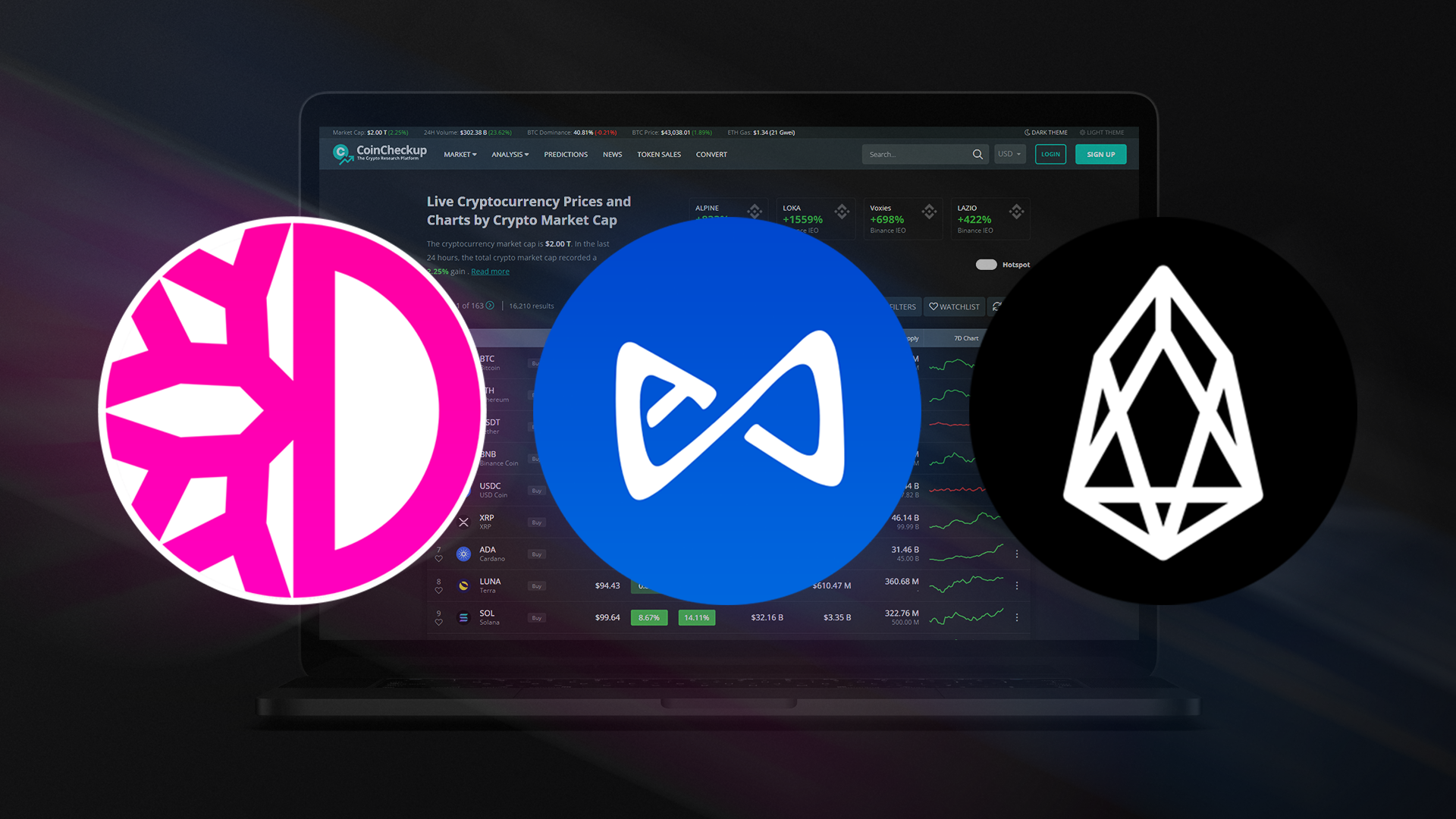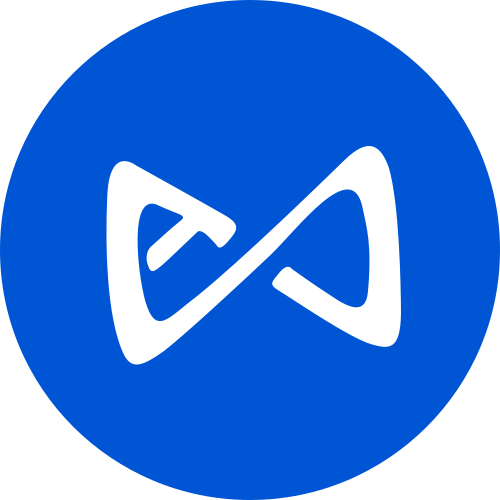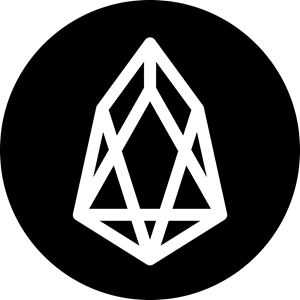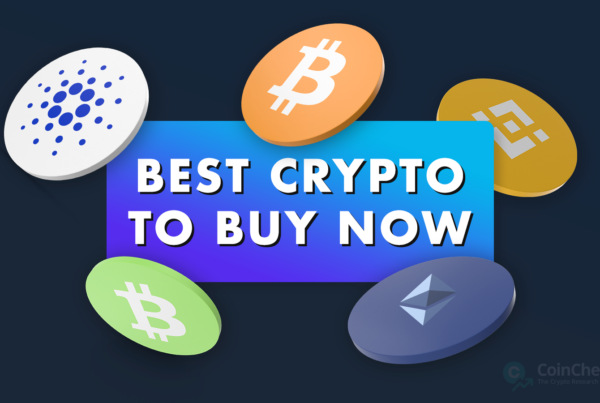
During the second consecutive rather uneventful week, the cryptocurrency sector’s total market capitalization fell from $874 billion to around $870 billion last. All top 3 non-stablecoin cryptocurrencies have also only deviated less than 1% from their respective prices at the beginning of last week. Furthermore, only 6 cryptocurrencies from the Top 100 have posted a weekly gain higher than 10%. These cryptos are CEL (Celsius Network,), AXS (Axie Infinity), STX (Stacks), FTT (FTX Token), EOS (EOS) and APE (ApeCoin). But how to identify these hidden opportunities in an otherwise stagnant market? We believe our Top 3 Coins to watch articles can be of great help in such situation.

3. DeFiChain (DFI)
DeFiChain is a proof-of-stake (PoS) blockchain anchored in the Bitcoin network (a proof-of-work blockchain). This allows DeFiChain to leverage the speed and efficiency of a PoS network, which utilizing Bitcoin’s PoW chain for additional security. Launched in May 2020, DeFiChain project essentially brings smart contracts and decentralized finance (DeFi) capabilities to the Bitcoin network. DeFiChain allows users to create their own wrapped assets and mint so-called decentralized tokens (d-tokens). Most commonly the wrapped assets are other cryptocurrencies such as Bitcoin, Ethereum, and other coins and participate in DeFi (dBTC, dETH, etc.), but the platform also supports the creation of tokenized equity and other real-world assets (for example, stocks, precious metals, real estate, etc.). DFI is the platform’s native token. It is used for paying transaction fees, receiving crypto rewards, as well as participating in the project’s governance, crypto swaps, and more.
Grand Central hard fork brings an on-chain governance to DeFiChain
DeFiChain blockchain underwent a governance-oriented upgrade called the Grand Central upgrade on December 8. The upgrade, which marks a major step in the development of the ecosystem triggered at block height 2,479,000.
Grand Central upgrade brough several features including a token consortium framework, fixes to the pool commission and reward system and support for masternode parameter updates. However, the most anticipated and most important feature of Grand Central was the launch of the on-chain governance (OCG), which will bring transparency of this DeFi ecosystem to new levels. As with other governance systems, users will be able to submit proposals (for example filing funding requests, votes of confidence, changing the block rewards allocation, etc.). Interested community members can follow ongoing voting processes on defiscan.live dashboard in real-time. In addition, the upgrade also introduced the DeFiChain Consortium, which was established to ensure that all decentralized digital assets issued in the DeFiChain ecosystem are backed at a 1:1 ratio. The consortium has the right to create (mint) new tokens or more importantly destroy (burn) tokens and thereby prevent the overminting of DeFiChain-based assets. DFI, which is currently trading at $0.47 looks poised to further appreciate because of the additional transparency and an added layer of security, which prevents undercollateralization of tokens issued within the environment.

2. Axie Infinity (AXS)
Axie Infinity is a Pokémon Go-inspired blockchain-powered trading and battling video game. The game is developed by a Vietnamese gaming studio Sky Mavis and has netted more than $2 billion in NFT sales to date. Axie infinity players utilize Ethereum-issued tokens AXS and Small Love Potion (SLP) to breed, trade and battle with their virtual creatures called Axies, each represented by a one of a kind NFT. The growing userbase and protocol revenue has made Axie Infinity one of the most expensive NFTs collections.
Axie Contributor initiative kicks off, anticipation of new features to be brought to the game by Axie Core is rising
Axie Infinity’s AXS saw renewed market interest in the past week because of the Axie Contributor initiative and upcoming gaming mechanics as part of Axie Core upgrade. Axie Contributor initiative is the second step of the project’s long-term strategy to further decentralize the Axie ecosystem. The project has recently selected close to 700 Lunacians from the ecosystem’s most active users, who take part in the pilot “season” of the Axie Contributors. Each participant will receive an acceptance letter, a Discord role, and most importantly access to a special “Governance” section in the Axie Infinity Discord. In the next step, Contributors will form Community Councils, which will soon take on an important role in the community and project development.
In addition, on December 5 Axies Infinity revealed the first outlines of the upcoming Axie Core upgrade, which is set to bring several advanced game mechanics and thereby further enhance players’ experience. After Axie Core is deployed to the mainnet, players will be able to equip and upgrade their accessories, breed Axies with a more immersive breeding interface as well as have a greater role in the upbringing of their Axies through new activities such as feeding and petting. The day after the outlines of the Axie Core’s features were made public, Axie NFT trading volume shot up 800% to more than $10.4 million. At the same time AXS pumped by more than 30%, indicating that the announced upgrade was very well received by players and investors.

1. EOS (EOS)
EOS is a blockchain platform that allows users to deploy smart contracts, run decentralized applications (DApps) and issue custom tokens. It launched its mainnet in June 2018 following a record-breaking initial coin offering (ICO), in which more than $4 billion were raised for the blockchain’s development. While many other chains such as Ethereum, TRON, Solana and other similar blockchains offer roughly the same features, EOS aims to distinguish itself from the competition through its improved scalability and faster transaction speeds. The chain utilizes a delegated proof-of-stake (DPoS) consensus model and boasts with the capacity to perform over 3,000 transactions per second (TPS).
EOS gains more than 12% as Binance launches support for USDT withdrawals and deposits through EOS Network
Last week Binance announced that they have integrated EOS Network-based USDT transactions. In other words, Binance listed EOS-based Tether (USDT), which allows Binance users to seamlessly transfer USDT in and out of the EOS Network without having to use a third-party bridge or swap their Tether for EOS or another cryptocurrency. The EOS Network Foundation noted that it took a lot of effort to reach this stage and hopes that the new seamless on-ramp will bring even more liquidity to the EOS ecosystem. In addition, the Foundation aspires for EOS to become the go-to network for transacting USDT stablecoin due to its top speed, good security, low cost, and high energy-efficiency.
In addition to Binance’s EOS-USDT integration things are also moving forward with the $100 million EOS ecosystem fund announced in November. The EOS Network Foundation (ENF) is in the process of establishing EOS Network Ventures (ENV), a separate entity that will manage the selection of projects and allocation of grants. ENF noted that the newly established ENV will make strategic equity and token-based investments across the Web3 space. As part of the ecosystem fund program, ENV will invest in GameFi, the metaverse, eSports, NFTs, and fintech projects building on EOS. To prevent any conflict of interest or other wrongdoing, the allocation of funds will be supervised by EOS Network validators. Thanks to the integration of EOS-based USDT on Binance and the recent announcement of the $100 million EOS ecosystem fund, EOS appreciated by more than 12% last week and landed among the largest gainers in the past week. However, EOS is very well-positioned for this week’s appreciation as well as long-term positive performance.



